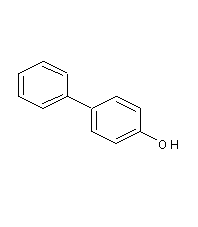
Structural formula
| Business number | 0251 |
|---|---|
| Molecular formula | C12H10O |
| Molecular weight | 170 |
| label |
phenylphenol, (1,1′-diphenyl)-4-phenol, 4-Hydroxybiphenyl, 4-Hydroxybiphenyl, 4-Hydroxy-1,1′-biphenyl, p-Biphenylol, p-Hydroxydiphenyl, Paraxenol |
Numbering system
CAS number:92-69-3
MDL number:MFCD00002347
EINECS number:202-179-2
RTECS number:DV5850000
BRN number:1907452
PubChem number:24866580
Physical property data
1. Properties: White needle-like or flaky solid.
2. Density (g/mL, 20/4℃): 1.111
3. Relative vapor density (g/mL, air=1): Undetermined
4. Melting point (ºC): 164.5
5. Boiling point (ºC, normal pressure): 306.5
6. Boiling point (ºC, 5.2kPa): Undetermined
p>
7. Refractive index: Undetermined
8. Flash point (ºC): 165
9. Specific rotation (º): Undetermined
10. Autoignition point or ignition temperature (ºC): Undetermined
11. Vapor pressure (kPa, 25ºC): Undetermined
12. Saturated vapor pressure (kPa , 60ºC): Undetermined
13. Heat of combustion (KJ/mol): Undetermined
14. Critical temperature (ºC): Undetermined
15 . Critical pressure (KPa): Undetermined
16. Log value of oil-water (octanol/water) distribution coefficient: Undetermined
17. Explosion upper limit (%, V/V ): Undetermined
18. Lower explosion limit (%, V/V): Undetermined
19. Solubility: Almost insoluble in water, soluble in ethanol, ether, acetone, Soluble in alkaline solution.
Toxicological data
Acute toxicity:
Main irritant effects:
On skin: Irritation to skin and mucous membranes.
On the eyes: effects of irritation.
Sensitization: No known sensitizing effects.
Ecological data
General Notes
Do not allow this product to come into contact with groundwater, waterways or sewage systems.
Water hazard class 2 (German Regulation) (self-assessment via list) The substance is hazardous to water.
Even small amounts of product seeping into the ground can pose a hazard to drinking water.
It is also harmful to fish and plankton in water bodies
If there is no governmentDo not discharge materials into the surrounding environment if permitted.
Toxic to organic matter in water.
Molecular structure data
1. Molar refractive index: 52.72
2. Molar volume (cm3/mol): 153.1
3. Isotonic specific volume (90.2K ): 395.6
4. Surface tension (dyne/cm): 44.5
5. Polarizability (10-24cm3): 20.90
Compute chemical data
1. Reference value for hydrophobic parameter calculation (XlogP): None
2. Number of hydrogen bond donors: 1
3. Number of hydrogen bond acceptors: 1
4. Number of rotatable chemical bonds: 1
5. Number of tautomers: 2
6. Topological molecule polar surface area 20.2
7. Number of heavy atoms: 13
8. Surface charge: 0
9. Complexity: 141
10. Number of isotope atoms: 0
11. Determine the number of atomic stereocenters: 0
12. Uncertain number of atomic stereocenters: 0
13. Determine the number of chemical bond stereocenters: 0
14. Number of uncertain chemical bond stereocenters: 0
15. Number of covalent bond units: 1
Properties and stability
1. It can be sublimated, so you should wear protective clothing when using it.
2. Exist in smoke.
Storage method
Should be sealed and stored away from light.
Synthesis method
Using the by-product distillation residue of phenol produced by the sulfonation method as raw material, the phenylphenol fraction is intercepted through vacuum distillation, and then the difference in solubility between o-phenylphenol and p-phenylphenol in trichlorethylene is used to realize the isomerization separation. It can also be obtained by hydrolysis of p-chlorobiphenyl at high temperatures.
Purpose
Used as dye; intermediate for resin and rubber. The red light sensitizing and green light sensitizing dyes synthesized by this product are one of the main raw materials for color films and are also used as analytical reagents. Colorimetric determination of acetaldehyde and lactic acid, quantitative determination of muramic acid. Inhibitor of deoxyribonuclease I. Intermediates for dyes, resins and rubbers, fungicides, solubilizers for water-soluble paints.

 微信扫一扫打赏
微信扫一扫打赏

